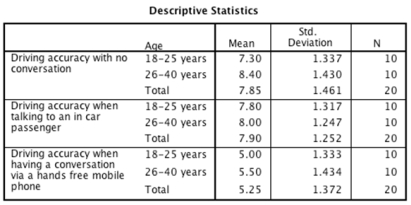An experiment was done to compare the effect of having a conversation via a hands-free mobile phone, having a conversation with an in-car passenger, and no distraction (baseline) on driving accuracy. Twenty participants from two different age groups (18-25 years and 26-40 years) took part. All participants in both age groups took part in all three conditions of the experiment (in counterbalanced order) , and their driving accuracy was measured by a layperson who remained unaware of the experimental hypothesis.
-What does the following output table tell us about the age variable? Tests of Between-Subjects Effects
Tests of Between-Subjects Effects
Measure: MEASURE_1
Transformed Variable: Average
Definitions:
Brain Imaging
Techniques and processes used to create visual representations of the brain's structure and function for medical and research purposes.
Operant Conditioning
Learning procedure in which the consequences (such as obtaining a reward) of a particular behavior (such as pressing a bar) increase or decrease the probability of the behavior occurring again; also called instrumental conditioning.
Reward Good Behavior
The process of positively reinforcing desired actions or conduct by offering incentives or praise, often used in training and behavior modification.
Extra Recess
Additional break time given to students during the school day, beyond the regular scheduled recess, for physical activity, relaxation, or social interaction.
Q2: A researcher was assessing customer satisfaction with
Q2: The HR manager conducted her evaluation of
Q6: Ordinal level data are characterized by<br>A) Data
Q8: Imagine we wanted to investigate whether a
Q8: In logistic regression, a classification table:<br>A)Indicates how
Q9: You have income data for your entire
Q9: A variable that shares none of its
Q12: An ANOVA was conducted on these data,
Q17: Which of the following statements best reflects
Q21: A 95% confidence interval for the difference